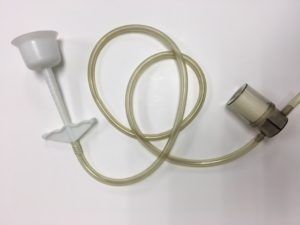A vacuum extractor is a small cup connected to a suction pump that may be used to help with the baby’s birth. The cup is placed on the baby’s head. During pushes, the caregiver will use the suction to help the baby move through the birth canal.
Vacuum extraction may be used to:
- Speed up delivery if the baby is in distress
- Speed up delivery if the labouring person is exhausted and unable to push
- Help with delivery if the labouring person is unable to push effectively because they can’t feel the urge to push due to an epidural
- Avoid a cesarean birth when vaginal delivery can be done safely
- Can also be used to help deliver the baby through the incision during a cesarean birth
Side Effects:
- Increases the risk of vaginal tearing, which can lead to a longer recovery time
- The extractor temporarily molds (shapes) or bruises the baby’s head. This bruising disappears within a few days
- Large amounts of bruising may increase the jaundice risk for the baby which can interfere with the baby’s early attempts at breastfeeding


Forceps
Forceps are metal devices that may be gently applied to the baby’s head to help with the birth. During pushes, the caregiver uses them to help the baby move through the birth canal and/or to turn the baby’s head to a better position to fit through the pelvis.
Forceps may be used to:
- Speed up delivery if the baby is in distress
- Speed up delivery if the labouring person is exhausted and unable to push
- Help with delivery if the labouring person is unable to push effectively because they can’t feel the urge to push due to an epidural
- Turn the baby’s head to a better position to fit through the pelvis
- Protect the head of a premature baby during delivery
- Avoid a cesarean birth when vaginal delivery can be done safely
- Help deliver your baby’s head during a vaginal breech birth
- Can also be used to help deliver the baby through the incision during a cesarean birth
Side Effects:
- An episiotomy may be necessary for a forceps delivery
- There may be an increased risk of bruising or a tear to the cervix and vagina which can lead to a longer recovery time
- Increased risk of hemorrhaging for the labouring person
- Forceps can cause bruising or red marks on the baby’s head. These usually fade within a few days
- Large amounts of bruising may increase the jaundice risk for the baby which can interfere with the baby’s early attempts at breast/chestfeeding
Episiotomy
Episiotomy is not a routine procedure and is not necessary in most normal labour and birth situations. There are some things that may reduce the need for an episiotomy:
- Maintain a good healthy diet to the end of pregnancy
- Practice perineal massage in the last month of pregnancy
- Doing pelvic floor exercises during pregnancy
- Discuss your preference of avoiding an episiotomy with your caregiver before going into labour
- Use upright or side-lying positions for pushing and birth as this provides less tension on the perineum
- Have your caregiver use perineal massage and warm compresses during pushing and crowning
- When the baby’s head is crowning, listen to and follow the guidance of the doctor or midwife to pause pushing and use small controlled pushes to ease the baby’s head out